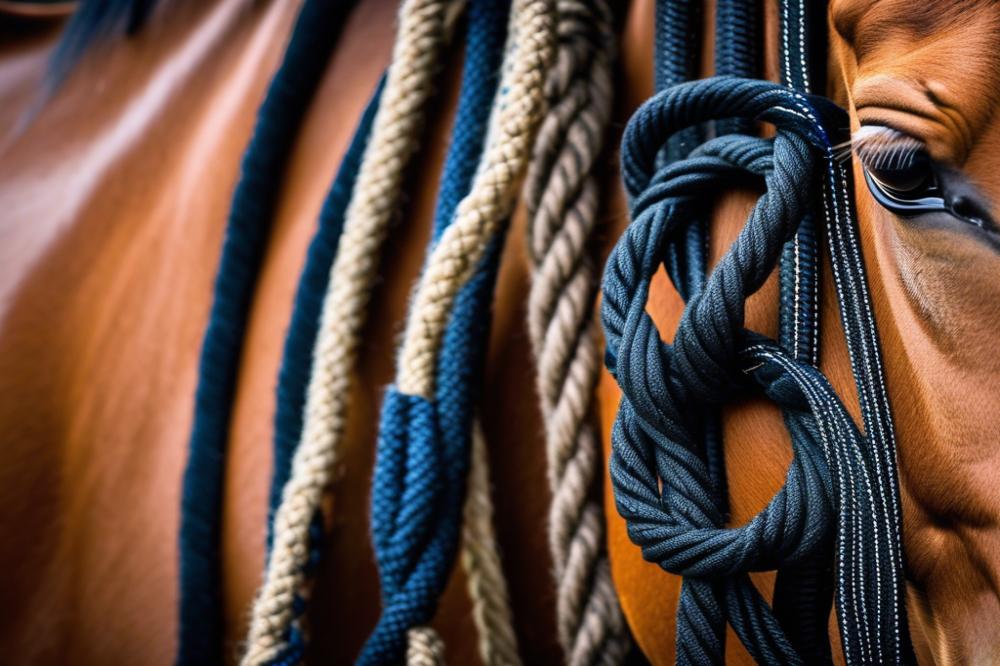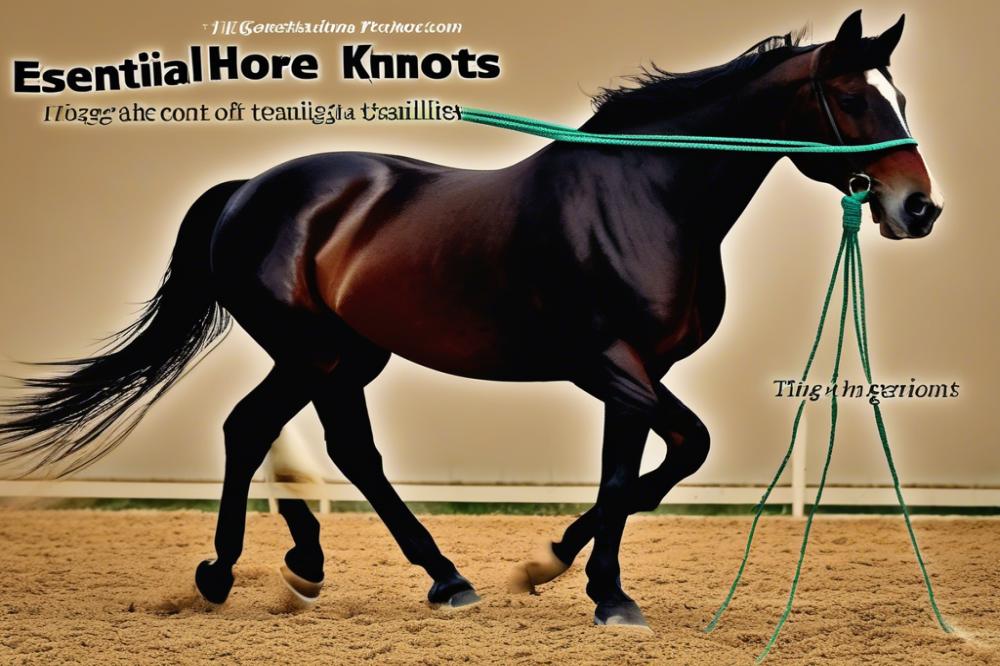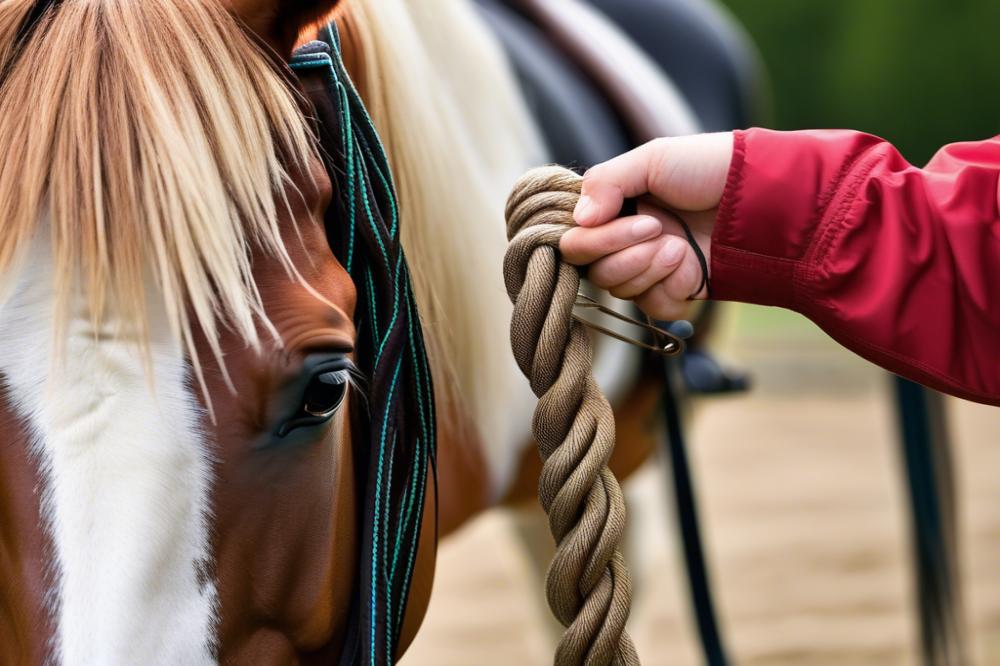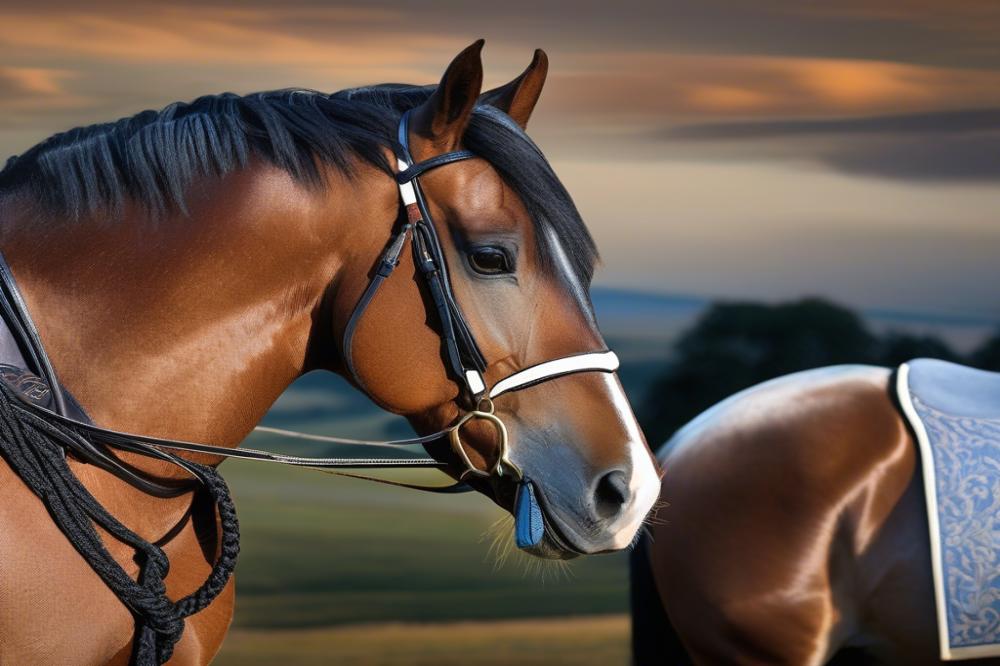What Are Horse Knots?
Have you ever been out in the barn, trying to tie your horse to the post, and found yourself wishing for a magic knot that wouldn’t slip or come undone? Well, you’re not alone! Horse knots are those nifty little ties that keep our four-legged friends safe and secure while we go about our equestrian techniques. Simply put, they are special knots used in horse handling that help prevent accidents and make life a whole lot easier for folks who work with horses, whether they’re in a stable or out riding.
Why Are Knots Important in Horse Care?
When it comes to horse training and care, tying knots correctly isn’t just a matter of convenience; it’s a matter of safety. Imagine a scenario where your horse is tied up and suddenly decides it would rather be anywhere else. A good knot can hold firm, keeping your buddy in place and avoiding any wild escapades that might lead to trouble. In contrast, a poorly tied knot could turn your peaceful grooming session into an unexpected rodeo adventure!
Moreover, knowing how to tie a few essential knots can build your confidence as a horse owner. Think about it: the more skills you have, the better you can manage different situations. Whether you’re out on a trail ride or just standing around the barn, being able to effectively tie and untie a horse can make all the difference in building a productive and stress-free relationship with your equine companion.
A Sneak Peek into What’s Ahead
In this article, we’ll take a journey through the world of horse knots. We’ll cover some of the most essential ties you need to master for effective horse handling, share tips on best practices, and even touch on how these techniques can vary between different animals, like the old debate of camels vs horses. Also, we’ll consider unique knots that serve specific purposes, so you can be prepared for any situation.
Curious about the lifespan of a Black Forest horse? We’ve got you covered too, as we tie in the nuances of different breeds and their care alongside our knot discussion. Grab a cup of coffee (or favorite drink), and let’s dive into the art of tying knots that make horse care not just manageable, but enjoyable!
Types of Horse Knots

Description of Common Horse Knots
Many equestrians know a few essential knots. The bowline is a favorite for its strength. It creates a fixed loop at the end of a rope. You can use it for tying to a post or securing a lead. Next up is the square knot, often used for tying two ends together. It’s a simple knot that is easy to remember. Many might call it a “tie-it-once-and-forget-it” kind of knot.
Another popular choice is the halter knot. This one is crucial for horse handling. It tightens when pulled, which helps in keeping a horse secure. A good slip knot is handy too. This knot allows the rope to slide but will hold tight when needed. Every horse owner should learn these basic knots for better horse care and training.
Brief Overview of Specialized Knots
Not all knots are equal. Some serve unique purposes. The anchor knot, for example, helps keep a horse in one place during grooming. This specialized knot stops the lead rope from slipping off a post. The垂直的搭扣 is another effective choice. It’s perfect for tying a horse to a trailer. You don’t want your buddy wandering off mid-ride, right?
When you think of equestrian techniques, always consider the figure-eight knot. It’s great for climbing or when you need a secure tie that unties easily. Lastly, the quick release knot shines in emergencies. If a horse panics, you can free them in a flash. Knowing these specialized knots enhances your skills and proves vital in various situations.
Comparison of Different Knot Types
Understanding knot types helps refine horse training techniques. Common knots may be easier to learn, but specialized knots hold important advantages. For instance, while the bowline is reliable, the quick release knot shines in emergencies. You’d want a knot that provides security without sacrificing speed.
Some knots, like the square knot, are great for tying things together. However, they can’t compare to the halter knot when it comes to horse handling. Each knot has its strengths, just like every horse has its personality. Choose wisely to fit the moment. Your choice in tying knots can make a difference, especially in training sessions or busy barn days.
Joining all these points boils down to this: mastering various knots is essential for any equestrian. You build confidence when you know how to tie them well. Each knot may seem simple on its own, but they each play a crucial role in keeping you and your horse safe.
Functionality of Horse Knots

Safety Aspects of Horse Knots
Horse knots play a crucial role in safety. A poorly tied knot can lead to accidents. Imagine a horse getting loose while you’re trying to brush it. Yikes! Using the right knot can prevent this kind of chaos. It’s vital to tie your horse securely to a post or trailer. The last thing you want is for your horse to wander off and get into trouble. Some knots can release quickly in an emergency. Others provide a firm hold, which is great for horse handling. Knowing when to use each knot is part of developing strong equestrian skills. Remember, a safe knot means a happy horse and a more relaxed rider.
Uses in Daily Horse Care
Daily horse care involves more than just feeding and grooming. Believe it or not, tying up your horse correctly is part of the routine. This is where equestrian techniques come into play. When grooming, a good knot keeps your horse steady. It also saves you from chasing your horse around the barn. You can take a moment to check hooves or apply fly spray without any distractions. Moreover, a secure tie helps during vet visits. Horses often get nervous around unfamiliar faces. A strong knot can be a lifeline for both you and your horse in such moments.
Role in Training and Handling Horses
Training and handling horses can be tricky. A well-tied knot can make all the difference. Imagine trying to lead a horse who decides it wants to go in the opposite direction. Now, that can get interesting! When you’re teaching a horse to stand still, a sturdy knot helps reinforce that behavior. You might find yourself using a specific knot for different training scenarios. Using unique knots can also become a teaching tool. Teaching someone else can solidify your own understanding of horse care. Just like you wouldn’t drive a car without knowing how to steer, handling a horse requires skill, and tying knots is part of that learning curve. In the world of horse handling, knots are more than just handy tools; they symbolize trust and control.
How to Tie Essential Horse Knots

Tying knots is a key part of horse handling and training. Every equestrian knows that mastering these skills makes life a lot easier. Whether you’re securing your horse or setting up equipment, knowing how to tie a few essential knots is vital. Let’s dive into step-by-step instructions for some commonly used knots.
Step-by-step instructions for common knots
The Bowline knot is a must-learn. Start by making a small loop at the end of the rope. Next, pass the working end of the rope through this loop from underneath. Now, wrap it around the standing part of the rope and pull it back through the loop. Tighten the knot, and you’ve got a secure loop that won’t slip!
Next up is the Halter Tie. It’s simple yet effective for horse care. First, create a bite with the rope. Then, wrap the working end around the standing part and back through the loop you just made. Pull tight to create a knot that’s easy to undo. You’ll find this handy when tying your horse to a post.
The Quick Release knot deserves a mention too. Imagine you need to release your horse in a hurry. Start by making a loop and placing the rope through it. You will then make another loop with the working part and go through the first loop. This knot slips easily when you pull the standing part, which ensures safety when you’re in a pinch.
Tips for beginners
Don’t rush the process. Tying knots can be tricky, so take your time. It can be helpful to practice with a friend; sometimes, a pair of eyes can spot mistakes you might have missed. Learning these equestrian techniques takes a bit of patience, but it’s worth it. Also, try using bright colored rope for practice. It makes it easier to see what you’re doing and where the twists and turns are.
Common mistakes to avoid
A typical error is tying knots too tightly. Remember, your horse needs to move comfortably! Don’t overlook checking that your knot is secure but not overly tight. Another blunder is forgetting to double-check your knots after you’ve tied them. It’s easy to miss a loose end, especially after a long day of horse training.
Lastly, avoid using the wrong knot for the task at hand. Each knot has a specific purpose. If you need to secure your horse, be sure to use a knot designed for that. Tying a decorative knot won’t keep your horse safe, after all. With practice, you’ll be tying knots like a pro in no time!
Tools and Materials for Knot Tying
Overview of Essential Tools
When diving into the world of tying knots, having the right tools is key. A sturdy pair of scissors should never be far away. You’ll also want a reliable lighter to seal nylon ropes and prevent fraying. Hands can get slippery, so a pair of gloves can help you maintain grip while you’re working on your equestrian skills. Don’t forget the clip! A good clip can make a knot easier to manage and untie when you need to.
Types of Ropes Suitable for Horse Knots
Choosing the right rope is crucial for effective horse care and training. Natural fibers like manila or cotton can be gentle on the horse and easy to handle. They can get a bit grippy when wet, which can be a hassle. Synthetic ropes such as nylon or polyester have a strong reputation for durability and resistance to wear. They’re perfect for outdoor use but can be a little slippery. Make sure to consider the purpose of your knot. Heavy-duty ropes suit tasks like tying gates, while lighter options work well for a quick hitch.
Care and Maintenance of Knotting Materials
Caring for your ropes will extend their life. Always dry them if they get wet. Store them in a cool, dry place with enough airflow. Inspect your materials regularly for any signs of wear. If you spot frayed ends, it’s time for a replacement to avoid accidents. A good wash can freshen up those dirty ropes. Just toss them in a bucket with some mild soap and rinse well. Proper maintenance is part of mastering horse handling. By treating your tools right, you’re setting yourself up for success in equestrian techniques.
Situations for Using Horse Knots
When to Use Specific Knots
Every equestrian knows that understanding when to use specific knots is key to horse handling. The right knot can make a world of difference during everyday tasks. For instance, securing a horse for grooming or tacking up is a common scenario. In this case, the quick-release knot is invaluable. This knot allows you to tie the horse safely yet gives you the option to free them in a hurry. It’s perfect for busy stables where things can get a bit chaotic.
Another example is the bowline knot, which forms a fixed loop. This comes in handy during horse training sessions. It provides a stable attachment point for various equipment. An application of this knot can be when you need to tether a horse while working on ground manners. Being able to tie up safely promotes better horse care.
Examples of Practical Applications
Think about trailering. The double bowline knot secures your horse inside a trailer snugly. You want your horse calm while traveling. It prevents unnecessary stress when they know they won’t slip or become loose. Stable owners often use the square knot when tying bales of hay together. It may seem simple, but using the right knot keeps everything neat and tidy.
Also, horse handling can be made easier with the trucker’s hitch. This knot is useful for securing equipment or even in emergencies. The added advantage is that it can create a significant amount of tension. This ability is quite useful when the stakes are high, such as during an event or competition.
Impact on Horse Behavior and Safety
Certain knots can impact a horse’s behavior positively. When properly tied, horses feel secure and calm. This leads to a happier animal who cooperates better with their handlers. On the flip side, a poorly tied knot can cause anxiety. Imagine a frightened horse with a loose knot. Chaos could easily break out. A few knots can even become tangled, leading to panic without the proper attention.
Tying knots with care doesn’t just keep equipment in place. It also promotes safety for both horse and rider. Proper knot technique helps owners feel more in control. That sense of assurance leads to better equestrian skills overall. Maintaining good practices fosters trust between horse and handler.
In essence, knots contribute significantly to how we handle horses. Building those equestrian techniques affects everything from daily care to training. Whether you’re working on horse training or just keeping things organized, never underestimate the power of a simple knot. They can truly make or break the experience.
Troubleshooting Horse Knots
Identifying Common Problems
When tying knots, even the best equestrian skills can falter. Horses may pull free when a knot isn’t secure, which can lead to trouble. Look for loose ends or uneven tension in the rope. A knot that seems fine might be hiding issues like twists or tangles. Sometimes, it’s simply a matter of the knot slipping under pressure. Observe your horse’s behavior too. An anxious reaction may mean something’s not right.
Solutions and Corrections for Faulty Knots
Fixing a faulty knot can be straightforward. First, untie the rope and inspect it closely. A clean start often solves the problem. When you tie again, ensure every loop is tight and neat. Use the right type of knot for the situation. A bowline, for instance, is great for creating a fixed loop. If a knot keeps slipping, try adding a half-hitch as a backup. This little addition can make a world of difference in preventing escapes during horse handling.
Understanding Horse Reactions to Knots
Understanding how a horse reacts can help you tie better knots in the future. A horse that fidgets might be bothered by the way a knot pulls on the halter. Some may even show displeasure with a stamped hoof or a swish of the tail. Pay attention to these clues. If your horse acts up, it’s time to reassess your knot-tying techniques. Good horse care means being aware of your horse’s feelings during training. A relaxed horse is less likely to pull against a knot, allowing you to focus on honing your equestrian techniques.
Wrapping It Up: The Importance of Horse Knots
Recapping the significance of horse knots feels a bit like gathering around the campfire after a long trail ride. These knots aren’t just handy tools; they’re vital skills every horse owner and rider should master. It’s often said that a good knot can mean the difference between a relaxed horse and an unexpected rodeo. With so much going on—like that time I saw a horse eating tree bark while my buddy was struggling to secure his saddle—having solid knot skills in your toolkit is simply smart.
Best practices play an important role, too. They go beyond just tying something up. Gently tugging on your work after you’ve finished can provide peace of mind. Remember to choose knots that are easy to untie but secure enough to keep your equine buddy safe while you’re busy—perhaps pondering the age-old question: does eating straw give horses colic? Compelling stuff, truly!
Embrace the art of practice! It’s much like learning to ride a bike. At first, it might feel a little wobbly and uncertain. However, consistent practice can transform you into a knot-tying aficionado in no time. Don’t be afraid to practice different styles! Grab a friend, share a few laughs, and turn this into an enjoyable experience. Even your horse will appreciate the extra attention while you ensure their comfort and safety.
To sum up, diving into the world of knot tying can be rewarding. With determination and a sprinkle of humor, you can master these essential skills. So go on, secure that halter, tie that lead rope, and show everyone how a well-tied knot can impress both horses and humans alike!



